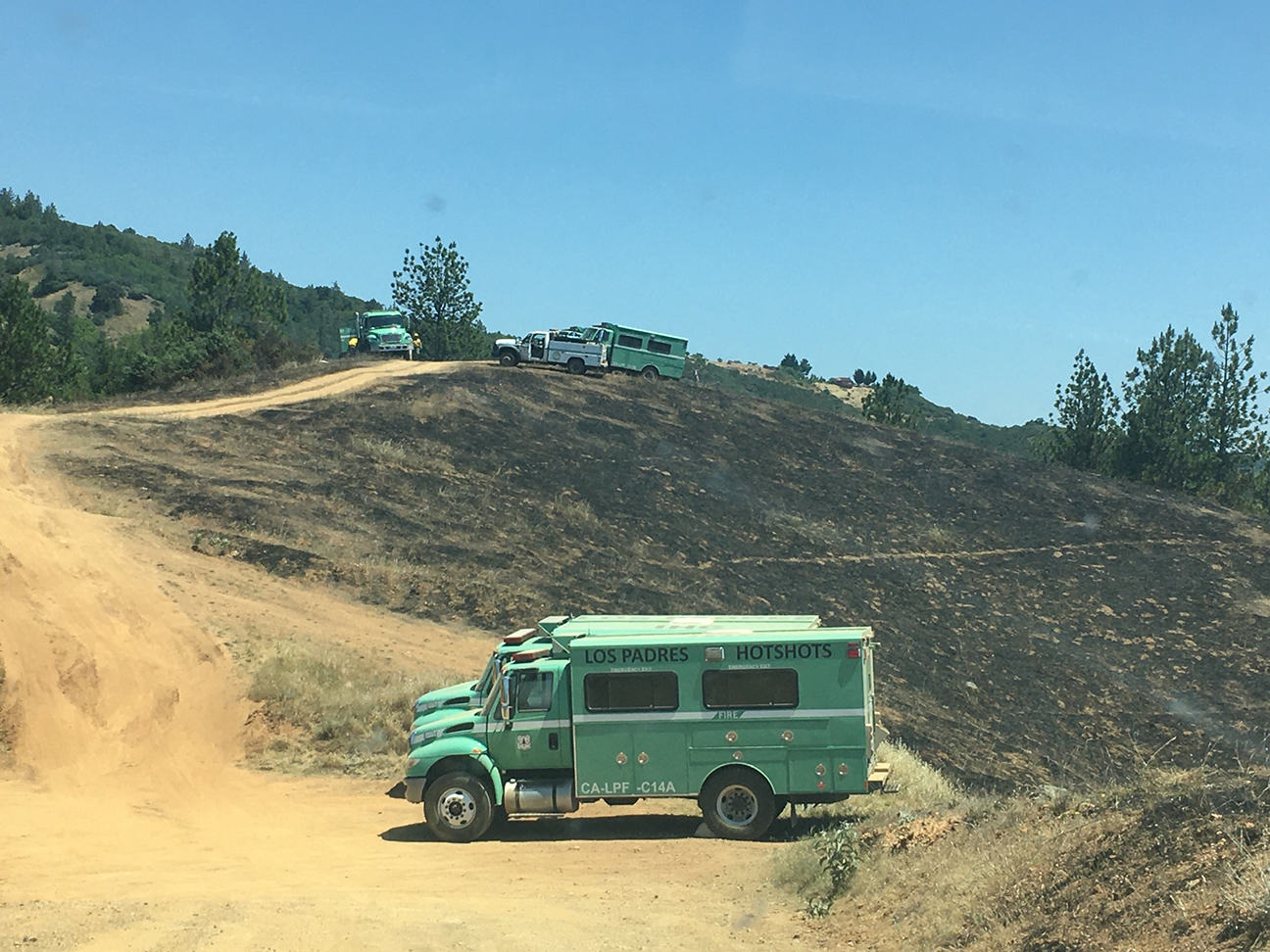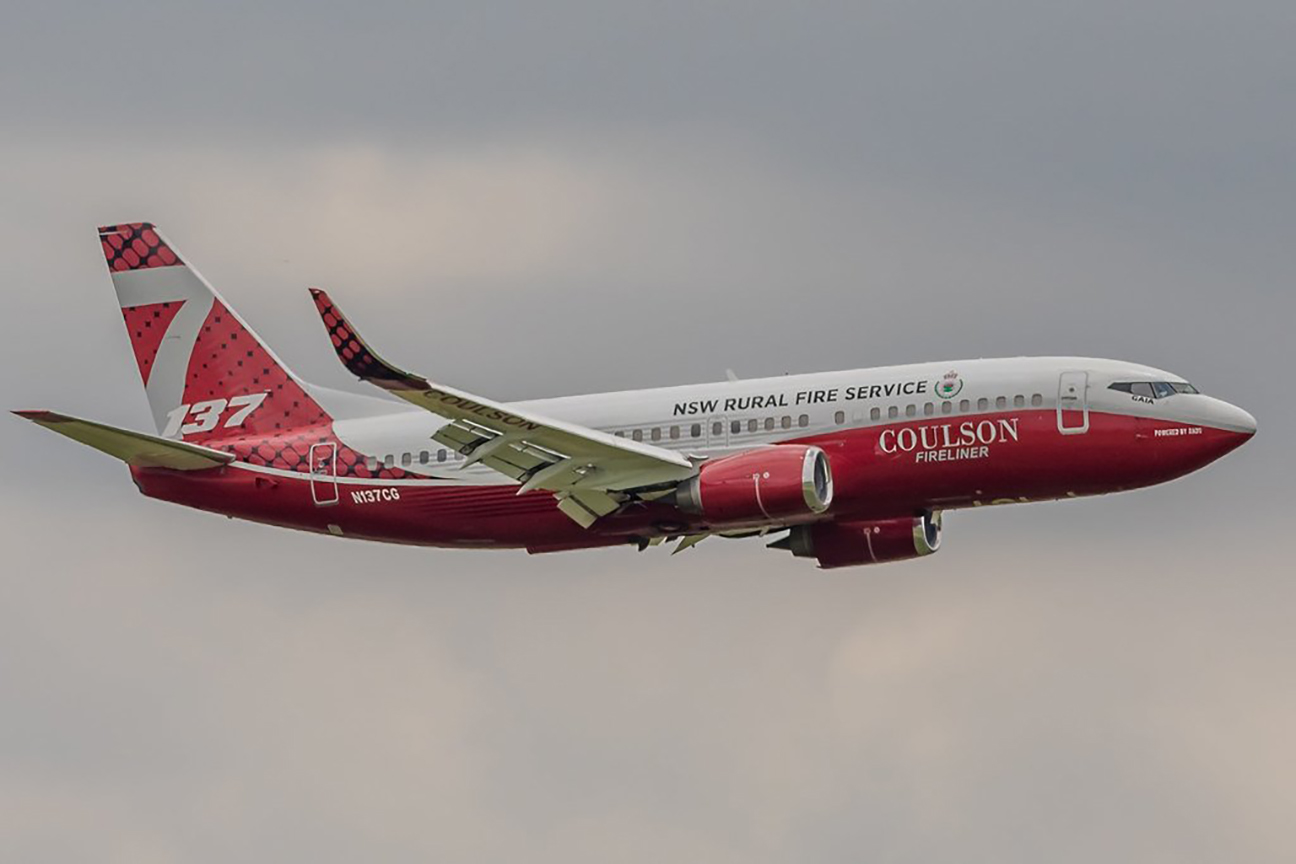The Ridge Fire | Photo by Brandon Shave
| FEATURED
By Kate Woods Novoa
I’ve been following wildland fires since I moved to the Big Sur backcountry in 1994 and survived my first close encounter in 1996. Big Sur has had a lot of fires since then, and I’ve closely monitored them all. But I had a new fire experience earlier this month that I hope never happens again: two fires in two weeks along the road leading to my house.
The first, on June 3, was called the Plaskett Fire and was caused by humans. The U.S. Forest Service says it is under investigation. The second, the Ridge Fire, started June 17. They were both put out quickly, but before describing how, I want to talk about the science of firefighting first.
I have studied the language of firefighting in my online interactions. Every year, I am immersed in the wildland fire culture in person and online. Fire is why I first learned how to blog and has been an all-consuming summer unpaid occupation for 12 years now, as more and more people use the backcountry, some of whom don’t have a clue about the dangers.
Over the years, my interest in wildfires has intensified. I have a whole shelf of fire books in my library that go back to the Firestorm in Peshtigo of 1871, the Great Hinckley Firestorm of 1894, and perhaps the most famous: the Big Blowup in Idaho of 1910. During that Idaho fire, a firefighter named Ed Pulaski saved all but five members of his 45-man crew by ordering them to shelter in an abandoned mine and threatening to shoot them if they tried to leave. His name may sound familiar — the Pulaski is one of the most beneficial firefighting tools, and Ed invented it.
I also became a huge fan of John Maclean and have all of his fire books. He does extensive research on any fire that results in the fatality of firefighters, taking two to three years to get all the details right. His books read like the best detective stories you have read.
Enlarge

Back to an old philosophy (Or: The only constant is change)
It is in trying to minimize risk to the firefighters that an old tactic has gained new life. After the Big Blowup, the goal of the U.S. Forest Service was to suppress any and all fires as quickly as possible. But fighting fire in the time of coronavirus is different, or should be different. Separation and masks are not possible among firefighters who travel to fires in their crew cabs from as far away as the Cleveland National Forest on the recent Ridge Fire and couldn’t breathe with masks in the conditions under which they labor.
In fact, the only real constant in the science of firefighting is that things tend to change. In the old days, a single ranger would go to the nearest town and recruit a number of men, often the town drunks, to accompany him with shovels, rakes, saws and whatever tools they could scavenge. The newest system, adopted in 2011, categorizes fires into three different types with three different approaches. Prescribed fires are meant to restore the fire-starved ecological balance. Natural fires are events such as lightning strikes, like the Basin Complex Fire of June 21, 2008. The last is human-caused, like the Soberanes Fire of 2016.
Also important to that model is the “geographic expression” of the working landscape, the wilderness, and the wildland-urban interface, or WUI. Neither the prescribed fire nor the natural fires are to be suppressed, according to Stephen J. Pyne, in a book he wrote called “California: A Fire Survey.” It is only the WUI fires that call for suppression, Pyne said.
During the time of coronavirus, wildland firefighters are returning to philosophy that fires should be suppressed as quickly as possible. They’re utilizing as many aircraft as possible in order to lessen the exposure risks of the “boots on the ground.” Large fires result in small cities being established nearby, where fire crews are in close quarters, eating, sleeping, working and traveling together, thus increasing the risk of coronavirus exposure. To avoid this confined environment — equivalent to that of a Navy ship, a cruise ship, or a prison — they are suppressing fires as quickly and as soon as possible.
Coronavirus have forced firefighting professionals to turn back the clock to before 1978, before wildland firefighting agencies recognized that suppression at any cost came with a heavy future cost.
“Fires that may have offered some benefit to the landscape will be suppressed before officials can even evaluate their potential,” according to Stephen D. Fillmore, in a story published earlier this month in Slate. Fillmore is a wildland fire manager working in Southern California and a doctoral student at the University of Idaho. “Worse, more aggressive tactics and a greater utilization of firefighting aircraft merely exchanges one risk problem for another, and actually may add several more. Already we’ve seen firefighters get hurt while working in places they previously would not have put themselves in just to try to keep even the most innocuous fires as small as possible.”
Gaia to the rescue
That tactic was clearly evident in the firefight on the Ridge Fire. The fire was called in at 1:40 p.m. by the person who accidentally started it with either hot exhaust or hot engine. I was notified at 1:42 by a direct message on Twitter from one of my longtime firefighting followers. Within that first hour, aircraft were on the fire. I counted four separate air tankers, one large T-137 air tanker, three firefighting helicopters, one USFS photography helicopter, and one air attack, a fixed-wing aircraft with a crew that coordinates all the firefighting aircraft, spots, and often leads the bigger aircraft in to guide the drop.
Two of the tankers were from the Paso Robles airport, two were stationed in Hollister. Tanker 137, the first firefighting Boeing 737 in the world, is owned by Coulson Aviation and was put into service in November 2018 in Australia. It is impressive and looks like what the fire service calls a Very Large Air Tanker, or VLAT. This plane has a nickname — Gaia. Its first pass was directly over my house, and I had retrieved my camera out of my van but was not fast enough, so I missed the photo of a lifetime. It had made three passes, and then went back to base with a load and hold order. Meanwhile, the Ridge Fire had been spotted over Plaskett Ridge Road to the north, so Gaia was called back for a final fourth run.
The Plaskett Fire on June 3 is being investigated, but was clearly human-caused. My son took photos of a couple who were parked in the exact location of where the fire started only two hours before my neighbor reported the fire. The couple clearly had a campfire going.
The Ridge Fire on June 17 was much more serious, although it wasn’t far from the first one. Firefighting units by Thursday morning had it 30 percent contained, but I could tell by Wednesday night that it would soon be controlled.
Fortunately, the Ridge Fire did not turn into what firefighters call a campaign fire. No small city was required. Fire officials only needed to work out of a command post set up at the Pacific Valley USFS Station, almost visible from the fire location.
Enlarge

Firefighting will have a new meaning during COVID-19
Meanwhile, Fillmore’s story in Slate described the complications of firefighting in the age of COVID-19. “Routine tasks at fires have taken on new meaning and consequence,” he wrote. “Social distancing requirements will complicate communication and potentially introduce novel safety issues. Sanitation and screening requirements at fire camps will reduce the amount of time firefighters can be in the field putting out the fire. Feeding crews will take more time and be more complicated, also reducing the time they can be working on the fire. Sleeping arrangements will require more space, which can be hard to come by in certain locales.
All this is important because the long-term outlook for the fire season calls for above-normal fire conditions through August. “Fires will bring smoke, and large fires, as always, will send untold volumes of lung-irritating particulates into nearby communities,” according to Fillmore. “The impacts of smoke to both firefighters and the public is a concern, but then again it’s always a concern. The science is well established that smoke exposure can be deleterious in long-term and high-volume exposures, but almost nothing is known about how smoke affects the pathology of people with COVID-19.”
This goes for communities as well as firefighters. Communities even only tangentially near the fires suffer the consequences of smoke inhalation.
Fighting wildfires in the time of coronavirus will require community involvement and understanding. The firefighting resources are going to be fundamentally more stressed. “They’re going to need help and support from the communities they are sent to protect,” Fillmore wrote. “We need to give them some slack if some fires end up getting a little bigger, especially in the backcountry. The trade-off is that maybe a fire closer to the community will remain small.”
The communities they are protecting are also stressed. We are very appreciative of the firefighting community, but we would also like to see more prevention. Big Sur residents have been telling USFS officials that we need help in preventing wildfires in the first place. We need patrols to catch and ticket thoughtless, irresponsible campers who start campfires when it is banned. We need the county to patrol the Nacimiento area, where camping is completely banned. Often budget constraints have been cited as the reason we can’t get any help. That may continue to be an issue, but Rep. Jimmy Panetta, D-Carmel, introduced legislation two weeks ago to bring more federal resources and money to the Monterey Ranger District for wildfire prevention and wildfire management.
I started writing this on Saturday morning while I was still receiving emails from neighbors telling me how awful Friday night was. The neighbors described illegal campfires, and campers who argued with them when the campers were asked to put them out. Several campers felt they had a right to a campfire despite numerous signs to the contrary. One neighbor, describing an escalating argument she had with a group of campers near her home, told me she felt like the campers were “trying to burn us in our beds.”
Fillmore’s story in Slate doesn’t address wildfire prevention in the time of coronavirus. In Big Sur, prevention would entail one or two patrols of all three backroads each Friday and Saturday nights, enforcing the laws with citations and fines. Social media would spread the word that enforcement has become aggressive and the behavior would stop. The fine for a campfire can be up to $5,000 and or six months in jail.
Adding aggressive prevention techniques to their existing firefighting powers would be an even more efficient way for the U.S, Forest Service to protect the firefighters against the spread of the coronavirus.
We can keep them out of the small cities erected for campaign fires where they live, work, sleep, and socialize among a large, densely packed community. We owe it to our amazing firefighters not to subject them to any more dangers than the job already entails. Our brave young men and women deserve no less. Let us take prevention out of the tool chest, and then actually use it.
Have something to say about this story? Send us a letter.